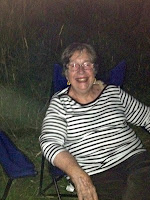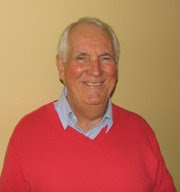A FEW ODDS AND SODS
Policeman’s Heel
In Ottawa we had friends who traded in their cars every three years. Unlike those of us who kept our cars longer (we usually traded in after 5 to7 years) they never had the ‘joy’ of learning about things like alternators, struts, or transmission belts. Their cars ran perfectly with nary a visit to the garage except for regular oil and lube jobs.
I’ve been thinking that one can draw a kind of analogy between the aging of cars and the aging of humans. The longer we live, the more we learn about the things that can go wrong with the human body. In recent conversations with other seniors we have heard about malfunctioning knees, hips, gall bladders, heart rhythm and on and on.
When I was young, I laughed to myself about old duffers---of both genders---describing their ailments. I thought it must be really boring for the people listening to those tales of pain and pills.
Now that I am an old duffer myself, I realize it is not boring at all to listen to someone tell about a health problem they are dealing with. I am too busy storing away information in case I too get an intermittent pain---‘just over here’---that may mean a gall stone attack. I wasn’t bored when someone described how he had to have his transmission belt replaced. I knew that that could happen to me, so I stored away that tale of woe. And now I stow away tales of ailments.
All of which may mean it is OK for me to talk about my latest ailment: plantar fasciitis.
Some months ago I was doing a little gardening and afterwards my right heel was tender. I decided that I had bruised it, and like other bruises it would eventually go away.
But it didn’t. Some days it didn’t hurt too much, but the tenderness never went away completely.
Then a week ago I was doing some strenuous walking around the track at our gym. Afterward the pain in my heel became so intense I had to use a cane.
The doctor said I had plantar fasciitis and, smiling sympathetically, told me he had once had it in both heels after a racket ball tournament. “It was so bad I couldn’t even limp”, he laughed. He prescribed an anti-inflammatory drug and recommended physical therapy. (The choice of an anti-inflammatory drug was tricky because I am on a blood thinner and can’t take oral drugs like Advil. He chose a liquid anti-inflammatory that is rubbed into the skin of the heel.)
The physical therapist went into detail about the mechanics of the foot: “I like to think of the foot as just a bag of loose bones. When we want to walk, the plantar fascia tendon that runs from the heel bone to the ball of the foot comes into action and pulls all the bones together. If something irritates the fascia, inflammation can set in and we feel pain when we walk.”
He used ultra sound to ease the inflammation, taught me some exercises to stretch and strengthen things, and recommended a cushioning heel cup.
I’m happy to say that things are on the mend.
You may have wondered about the title I chose for this story: ‘Policeman’s Heel’. Apparently in the olden days when policemen pounded the beat, they often developed plantar fasciitis. It was so common, doctors referred to the problem as ‘Policeman’s Heel’.
Now, my father was a policeman (Ontario Provincial Police).
You don’t suppose there is something genetic going on here?
REMEMBERING THE CNE’S ‘PETE THE PEELER’
We had an invitation to accompany some friends to the Canadian National Exhibition (also CNE or ‘the Ex’) in Toronto in August but had to decline. The invitation brought back memories of my first visit to the Ex, in 1948. The CNE grounds had been taken over for the War effort and were only returned to the City of Toronto in 1947, which then began planning for the first post-war Ex in the following year.
My parents gave me (12 at the time) and my brother Chuck (9) a few dollars and told us to meet them at the fountain in the late afternoon. (Everyone always arranged to meet at the fountain!)
We toured the booths in Food Building, which at that time offered free samples---in later years they charged for them. We went on a few rides in the midway and then climbed up into the Grandstand to watch Jack Kochman's Hell Drivers perform amazing stunts with Yellow Dodge cars. (The CNE archives have a
brief film shot by a visitor in 1950 that shows some of the Hell Driver stunts: The film is blurry but it does bring back a host of memories!)
One of my strongest memories of that day at the EX is of listening to the marketers my family had dubbed ‘the Pete the Peelers’. They were men (I can’t remember any women) who demonstrated and sold various household items. I am assuming that the nickname came from the 1920s and 1930s when the potato peeler was being introduced as a replacement for the paring knife. By 1948 the potato peeler had been accepted in most homes and while the Pete the Peelers were still selling them, they packaged them with gadgets that sliced, diced and shaped vegetables into exotic shapes. While they demonstrated a gadget they kept up a folksy patter with the crowd of women, not flirting exactly but flattering them outrageously.
Other men demonstrated items such as cloths that would prevent eye glasses and windshields from fogging up, and imitation chamois clothes that would dry a car without streaks.
But the stand that really fascinated me was one that sold glass cutters. At home, when we needed a piece of glass we always went to the hardware store, which had a diamond tipped glass cutter. The Ex man selling the glass cutters said that it was no longer necessary to buy an expensive diamond glass cutter, or to travel to a hardware store. “Modern technology has created a glass cutter with a tip of hard amalgam, and for just a dollar you can cut your own glass”.
We had a stock of odd-sized sheets of glass at home and I thought that it would be great to be able to cut a piece to replace a broken window or to fit into a picture frame.
The salesman demonstrated straight cuts and fancy, curvy cuts. He scored the glass and then effortlessly broke off the piece he had been working on.
I succumbed and bought a cutter.
When I tried it at home, the glass broke every which way, every time I used it. I was disappointed and felt that I had been taken.
A couple of weeks ago we had dinner with another couple and the Ex came up. I told the glass cutter story. The husband, who had grown up in Toronto and regularly attended the Ex, remembered being fascinated as well by the people selling the cutters but he hadn’t bought one.
I said that my theory was that although the seller made a point of using a cutter from one of his packages, he had used some sleight of hand and was, in fact, using a diamond-tipped cutter. I said that after more than sixty years I still felt annoyed at being taken.
Our friend had another theory. He asked whether I had noticed how thin the glass was that was being used in the demonstrations. I hadn’t. According to our sharp-eyed friend, the glass was much thinner than the standard glass used around a home. It was, therefore, much easier to cut.
Whether the man tricked us by sneaking in a diamond-tipped tool or by using extra thin glass the point is he did trick us.
I suppose I learned a pretty cheap lesson, one that I think about when I see some ‘wonderful, unbelievable’ gadget being advertised on television.
Thanks, CNE!
SOME APPS WE LIKE
When I was young people shared plant cuttings, recipes, and (sometimes) the location of favourite fishing holes. Today, they share favourite smart phone apps. Friends and relatives have been very generous in tipping us off to useful or entertaining apps.
I would like to return the favour by listing a few apps that we particularly like. These are for iPhones and iPads and available through iTunes but I am sure that there are versions available for android and Blackberry devices.
MarineTraffic. $3.99
The Niagara-on-the-Lake owner of a large sailboat introduced us to this app, which lets one:
“Watch the positions reported by more than 60000 vessels per day on an interactive map. The application provides worldwide coverage of more than 2000 ports and a significant number of open-sea areas.
Port arrivals and departures are recorded in real-time. Search for current conditions in ports, vessel details, historical data and estimated time of arrivals.”
We use the app primarily to find the location of ships in the Welland Canal so that we can tell which bridges are likely to be up but (because we are nosey) we also use it to check the name of ships out in the lake as we drive along the QEW.
Friends on a cruise? You can watch the progress of the ship from port to port.
Amazing!
BorderTimes. Free
The BorderTimes website describes the app this way:
“BorderTimes is a Free iPhone application developed by GeoGrant.com.
BorderTimes gives you the ability to access US/Canadian land border (Customs & Immigration) wait times from your iPhone or iTouch. The application offers both a Northbound and Southbound Quick View that lists all the land borders along with a green, yellow or red icon (indicating wait time). A button in the upper right-hand corner of the screen allows you to toggle between Passenger, Nexus and Commercial wait times.”
The app tells us which bridge has the shortest wait time when we are going to the States: Queenston/Lewiston, the Rainbow (Niagara Falls) or the Peace Bridge (Fort Erie). We also use it for the return trip to Canada.
The information is updated hourly. On particularly busy days, we may also call the Niagara Bridge Information number, 1 (800) 715-6722 for between-the-hour updates.
Remove Duplicate Contact $0.99
From time to time my iPhone list of contacts decides to reproduce itself and suddenly instead of one listing for, say, Mary Jones, I have three or four---all identical. Perhaps I am doing something wrong (always possible) or maybe it is just the machine ‘acting out’. I really don’t know but from the number of questions posed to support groups I don’t seem to be alone.
I started going through eliminating the duplicates one by one but quickly decided, “Hey I have better things to do with my time’.
Then I found the “Remove Duplicate Contact” app.
It removed all the duplicates in about 30 seconds!
Wow!
(In doing a double check on the app I found that it doesn’t work with the new IOS 6 operating system. However the developer of the app has provided Apple with an update that will fix the problem. He expects it to be accepted soon. If you have a problem with duplicate contacts, I suggest you check with iTunes in a couple of weeks.)
Toca Kitchen Monsters. Free
This app had a test run at a recent family reunion and we would recommend it for people from 2 to at least 76. Try feeding the monster broccoli or lemons and enjoy the sights and sounds of his displeasure. Or put too much salt or pepper on items he normally loves, such as carrots, or hot dogs.
A nice antidote when the cares of the world are getting you down!
Note:
The next Letter from Virgil will hopefully appear in a couple of weeks.
I am also hoping that Posting #12 in the companion Icewine Guru Blog will appear in the next little while.
http://theicewineguru.blogspot.ca



_edited-1.jpg)

















